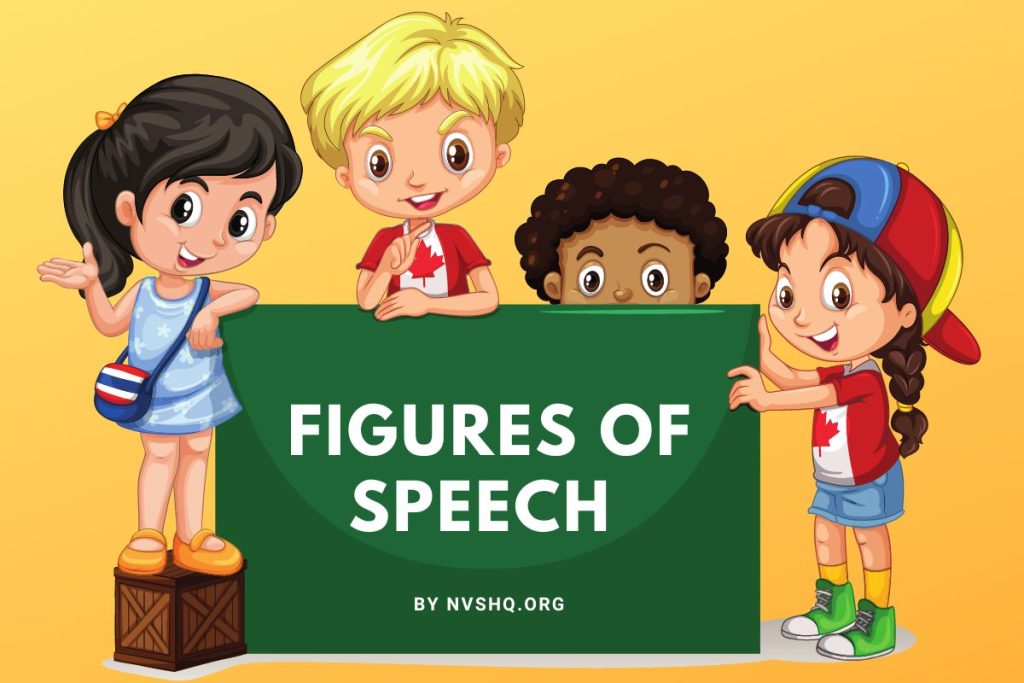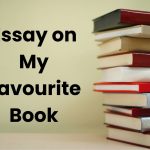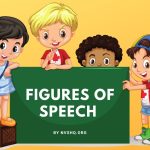
Figures of Speech- Figures of Speech make any spoken or written language unique, attractive and powerful. They are powerful tools to help our readers understand and stay interested in our work. A figure of speech is a rhetorical device which when used in a sentence produces a more powerful and strong impact. In our day-to-day life, we use so many figures of speech and we are not aware of it.
What are Figures of Speech?
A figure of speech is an expression used to make more effect on the reader or listener. Their actual meaning is different from the literal meaning. According to the definition of Oxford Learner’s Dictionary, a figure of speech is defined as:
A word or phrase used in a different way from its usual meaning in order to create a particular mental picture or effect.
Oxford Learner’s Dictionary
According to the definition of The Cambridge Dictionary, The Figures of Speech are defined as:
An expression that uses words to mean something different from their ordinary meaning.
The Cambridge Dictionary
Collins Dictionary defines The Figures of Speech as:
An expression or word that is used with a metaphorical rather than a literal meaning.
Collins Dictionary
So it is very clear from the above definitions that Figures of Speech are a rhetorical device which when used in a sentence produces a more powerful impact and their original meaning is different from the literal meaning. There are around fifteen to twenty figures of speech in the English Language let us have a look at each one now.
Note: Don’t get confused between Figures of Speech and Parts of Speech.
Different Figures of Spe- Personification
This figure of speech gives human characteristics to something that is not human. The Cambridge Dictionary defines personification as ” the act of giving a human quality or characteristics to something which is not human.” Personification is used to bring deeper meaning to the object or quality being personified. For example:
- During the thunderstorm, the lighting danced across the sky.
- I was scared when the wind howled at night.
Here lighting and wind both are given human traits of dancing and howling.
Some examples of personification from famous literature:
Personification in Shakespeare’s Romeo and Juliet
In Act 2, Scene 2 Shakespeare presents a personification when Romeo compares Juliet to the sun and describes that the moon is envious of her beauty.
But, soft! what light through yonder window breaks?
It is the east, and Juliet is the sun.
Arise, fair sun, and kill the envious moon,
Who is already sick and pale with grief,
William Shakespeare, Romeo and Juliet
Metaphor
In this figure of speech, two different types of things having a common link between them are compared with each other. It makes comparisons of two different types of things which have something in common with them. It is different from simile and another figure of speech as a metaphor is an indirect comparison whereas a simile is a direct comparison. For example –
- She has a heart of gold.
- She is a night owl.
Here in the first sentence heart is compared to gold that is it is pure like gold. In the second sentence the person is compared to a night owl meaning that the person generally stays up late at night.
A metaphor used in famous literature :
Metaphor in The Kite Runner by Khaled Hosseini
“Behind him, sitting on piles of scrap and rubble, was the blue kite. My key to Baba’s heart.”
Khaled Hosseini, The Kite Runner
A kite is compared to a key to someone’s heart.
Simile
Similes are figures of speech in which a direct comparison is made between two different things having similar qualities. They are often confused with metaphor but the difference between the two is that here direct comparison is established. Words like “as” or “like” is used to establish the relation. For example-
- As sweet as sugar.
- Runs like a horse.
Simile example used in famous literature :
Simile in Daffodils by William Wordsworth
“I wandered lonely as a cloud that floats high o’er vales and hills”
William Wordsworth, Daffodils
Alliteration
Alliteration is mostly used in poetry. In this figure of speech, the words of the same sounds or letters especially consonants (non-vowels) are used at the beginning of a series of words. For example –
- She sells sea shells on the seashore.
- Go and gather the green leaves on the grass.
Alliteration example used in famous literature :
I Know Why The Caged Bird Sings by Maya Angelou
“Up the aisle, the moans and screams merged with the sickening smell of woolen black clothes worn in summer weather and green leaves wilting over yellow flowers.”
Maya Angelou,I Know Why The Caged Bird Sings
Onomatopoeia
Words which are similar to the sound they produce are called onomatopoeia. This figure of speech is used to express a sound. According to Merriam-Webster, onomatopoeia is “the naming of a thing or action by a vocal imitation of the sound associated with it.” For example-
- The snake was hissing loudly.
- The bee is buzzing.
Onomatopoeia example used in famous literature :
Harry Potter and the Sorcerer’s Stone by J.K. Rowling
“SMASH The door was hit with such a force that it swung clean off its hinges and with a deafening crash landed flat on the floor.”
J.K. Rowling, Harry Potter and the Sorcerer’s Stone
The figure of Speech -Hyperbole
Hyperbole is used to exaggerate the importance of something more than it really is. According to the definition of The Oxford Learner’s Dictionary, a hyperbole is “a way of speaking or writing that makes something sound better, more exciting, more dangerous, etc. than it really is”. For example-
- He called her sister a pea-sized brain person.
- I have told you a million times to close the door after you leave.
Hyperbole example used in famous literature :
As I Walked Out One Evening by W.H. Auden
I’ll love you, dear, I’ll love you
Till China and Africa meet,
And the river jumps over the mountain,
And the salmon sing in the street.
W.H. Auden,As I Walked Out One Evening
The figure of Speech -Euphemism
These figures of speech are used to replace more harsher and explicit phrases to sound more polite. People always use euphemisms to refer to something unpleasant or embarrassing in a more acceptable way. For example –
- He passed away in his sleep. Instead of using “died” we used “passed away.”
- Senior citizens should practice yoga daily. Here “senior citizens” are used instead of “old people.”
Euphemism example used in famous literature:
Dropping the Euphemism, Bob Hicok
When I said
I have to lay you off
a parallel universe was born
in his face, one where flesh
is a loose shirt
taken to the river and beaten
against the rocks. Just
by opening my mouth I destroyed
his faith.
Bob Hicok ,Dropping the Euphemism
Instead of “fire you” the poet has used “lay you off.”
The figure of Speech -Irony
Irony or sarcasm is a figure of speech in which the words convey the opposite of the literal meaning. It is a subtle form of humour. According to the Oxford Learner’s Dictionary the term ‘irony’ is defined as “the use of words that say the opposite of what you really mean, often as a joke and with a tone of voice that shows this”. For example-
- When it started raining, he exclaimed ironically, “What beautiful weather!”
- Your feet are as clean as mud.
The irony example used in famous literature:
The Rime of the Ancient Mariner by Samuel Taylor Coleridge
In the famous line “Water, water, everywhere, nor any drop to drink,” Coleridge uses a classic example of irony in literature. While the character is dying of thirst, he is surrounded by water he cannot drink.
The figure of Speech -Anaphora
In this figure of speech words or phrases are repeated at the start of several sentences. It is generally used in children’s rhymes or dramatic speeches. For example-
- “So let freedom ring from the prodigious hilltops of New Hampshire. Let freedom ring from the mighty mountains of New York. Let freedom ring from the heightening Alleghenies of Pennsylvania…” (From Martin Luther King’s “I Have a Dream” speech).
- In the poem “London,” by William Blake: In every cry of every Man, In every infant’s cry of fear, In every voice, in every ban, The mind-for’d manacles I hear.
Anaphora example used in famous literature:
Charles Dickens’ A Tale of Two Cities
It was the best of times, it was the worst of times, it was the age of wisdom, it was the age of foolishness, it was the epoch of belief, it was the epoch of incredulity, it was the season of Light, it was the season of Darkness, it was the spring of hope, it was the winter of despair, we had everything before us, we had nothing before us, we were all going direct to Heaven, we were all going direct the other way—in short, the period was so far like the present period, that some of its noisiest authorities insisted on its being received, for good or for evil, in the superlative degree of comparison only.
Charles Dickens’, A Tale of Two Cities
The figure of Speech – Pun
Puns are the most commonly used figure of speech in day-to-day conversation. They are considered great conversation starters and make someone sound witty and comical. Pun includes the play of words which have more than one meaning. For example-
- She had a photographic memory but never developed it.
- A chicken crossing the road is truly poultry in motion.
Pun example used in famous literature:
Alice in Wonderland by Lewis Carroll
“Mine is a long and sad tale!’ said the Mouse, turning to Alice, and sighing. ‘It is a long tail, certainly,’ said Alice, looking down with wonder at the Mouse’s tail; ‘but why do you call it sad?’ And she kept on puzzling about it while the Mouse was speaking.”
The figure of Speech – Apostrophe
According to the Oxford Dictionary, the apostrophe is defined as “a rhetorical figure in which the speaker addresses a dead or absent person, or an abstraction or inanimate object”. It is used to address someone who is absent, already dead or an abstract idea or even a non-living thing. For example –
- Twinkle, twinkle little star, How I wonder what you are
- Oh rose, how sweet you smell and how beautiful you are!
Apostrophe example used in famous literature:
Macbeth by William Shakespeare
Macbeth hallucinates a dragger when he going to murder the king and addresses it by saying
Is this a dagger which I see before me,
The handle toward my hand?
Come, let me clutch thee.
I have thee not, and yet I see thee still.
Art thou not, fatal vision, sensible
To feeling as to sight?
William Shakespeare, Macbeth
Figures of Speech – Paradox
Paradoxes are similar to ironies as paradox also emphasises something by discussing the exact opposite of it. The difference between the two is that in paradox the dissimilarity is not as obvious as in irony. For example-
- “Some of the biggest failures I ever had were successes.” (As said by American actress Pearl Bailey).
- “War is peace. Freedom is slavery. Ignorance is strength.” (As said by English novelist George Orwell).
Paradox example in famous literature:
Animal Farm by George Orwell
Animals Farm by Orwell uses paradox in this statement:
All animals are equal, but some animals are more equal than others.
George Orwell, Animal Farm
The figure of Speech – Oxymoron
This figure of speech is used to connect two opposite terms one after the other to bring more effect. It should not be confused with Irony and Paradox. The Collins Dictionary defines an oxymoron as “a figure of speech in which opposite or contradictory ideas or terms are combined.” For example-
- Awfully good
- Deafening Silence
Oxymoron example in famous literature:
Lapis Lazuli by William Butler Yeats
“One asks for mournful melodies;”
William Butler Yeats, Lapis Lazuli
The figure of Speech – Assonance
Assonance is the figure of speech in which words having similar vowel sounds are used consecutively. It can be considered as the opposite of alliteration. Here vowels are repeated without the repetition of consonants. For example –
- They seemed to like the green peas salad.
- How now, brown cow?
Assonance example in famous literature:
Daffodils by William Wordsworth
“A host, of golden daffodils”.
William Wordsworth,Daffodils
The words host and golden have a similar ‘o’ sound.
The figure of Speech- Metonymy
In metonymy, one term or phrase is replaced by another term which is closely related to it. According to the Oxford Learner’s Dictionary, ‘metonymy’ is defined as “the act of referring to something by the name of something else that is closely connected with it”. For example –
- The pen is mightier than the sword.
- Everyone should pledge their allegiance to the crown.
Pen and crown words are used in place of “words” and “king”.
Metonymy example in famous literature:
William Shakespeare’s Julius Caesar
“Friends, Romans, countrymen, lend me your ears.”
William Shakespeare’s, Julius Caesar
“Ears” is used in place of attention.
The figure of Speech -Antithesis
Antithesis according to the Oxford Learner’s Dictionary, is defined as “a contrast between two things”. In antithesis, strongly contrasting ideas are in juxtaposition. For example-
- Hope for the best; prepare for the worst.
- Keep your mouth closed in your eyes open.
Antithesis example in famous literature:
Hamlet (William Shakespeare)
Give every man thine ear, but few thy voice;
Take each man’s censure, but reserve thy judgment.
William Shakespeare, Hamlet
The figure of Speech – Climax
A figure of speech in which ideas, words, phrases, clauses or sentences are arranged in increasing order of their importance. For example-
- “To infinity, and beyond!”
- If you think that’s bad it will get worse.
The figure of Speech – Anticlimax
A figure of speech in which ideas, words, phrases, clauses or sentences are arranged in decreasing order of their importance. For example-
- I die,I faint, I fall.
- She lost her family, her house, and her car.
Anticlimax example in famous literature:
The Deserted House by Alfred Lord Tennyson
“Come away: for Life and Thought
Here no longer dwell;
But in a city glorious—
A great and distant city—have bought
A mansion incorruptible.
Would they could have stayed with us.”
Alfred Lord Tennyson, The Deserted House
Read the following topics also to improve your writing skills
- Diary Writing Formats Entries, Sample, Example and How to write.
- Notice Writing, Formats, Tips, Sample and Examples
- The 8 Parts of Speech | Chart, Definition & Examples
A figure of speech is a rhetorical device which when used in a sentence produces a more powerful impact






